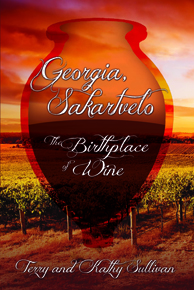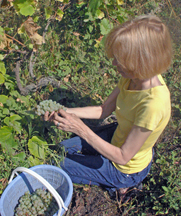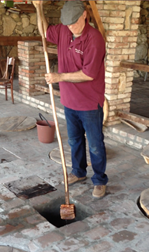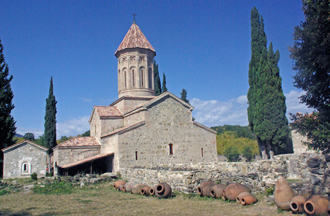
The Book: Georgia, Sakartvelo: the Birthplace of Wine
 Georgia, Sakartvelo: the Birthplace of Wine by Terry and Kathy Sullivan reveals a cultural world unknown to many people. The country of Georgia is located to the east of the Black Sea between the Greater Caucasus Mountains and the Lesser Caucasus Mountains. This is a land with a Mediterranean climate where wine, history, food and religion intermix. The people in this region have been making wine continuously for 8,000 years. Discover the qvevri winemaking method that has been used to make natural wine for centuries. Terry and Kathy take readers into Georgia’s culture with an emphasis on wine and history.
Georgia, Sakartvelo: the Birthplace of Wine by Terry and Kathy Sullivan reveals a cultural world unknown to many people. The country of Georgia is located to the east of the Black Sea between the Greater Caucasus Mountains and the Lesser Caucasus Mountains. This is a land with a Mediterranean climate where wine, history, food and religion intermix. The people in this region have been making wine continuously for 8,000 years. Discover the qvevri winemaking method that has been used to make natural wine for centuries. Terry and Kathy take readers into Georgia’s culture with an emphasis on wine and history.
Inspiration for the Book: Georgia, Sakartvelo: the Birthplace of Wine
What inspired us to write a book about the country Georgia and its connection with wine? Different experiences at different times provided sparks of inspiration. Several years ago, Kathy and Terry decided that, “If we are going to write about wine, we should make wine.” That idea sprang into action in 2008, the year we made three wines at home. The following year, we were making wine at a winery in Virginia and a winery in Maryland. We have continued to make wine ever since. Inspired by our success, we wanted to learn more about winemaking. We took online winemaking courses through Washington State University and attended several winemaking and wine growing conferences. In September 2013, we were offered the opportunity to help make wine in the country Georgia. All of these varied experiences provided us with the knowledge we needed to write the chapter about winemaking in Georgia, Sakartvelo: the Birthplace of Wine.
At the International Wine Tourism Conference (IWINETC) in Perugia, Italy in 2012 the country of Georgia caught our attention and a book idea began fermenting in our minds. Terry attended a presentation by Ia Tabagari about Georgian wines and winemaking techniques. She showed photos of qvevris. We had seen our first qvevri at Vinopolis in London in 2007. After the presentation Ia asked if the group had any questions. Terry raised his hand and asked a winemaking question, “How do you clean a qvevri?” Perhaps the most important thing we learned about winemaking is cleaning, so for us this was a logical question. Ia explained to the attendees how winemakers in Georgia use a brush made of cherry bark to clean the inside of a qvevri. The idea of cleaning with a cherry bark brush was so unique, it piqued our curiosity. We just had to learn more and write about the wines and winemaking in Georgia.
 In 2013 the International Wine Tourism Conference was held in Zagreb, Croatia. A Georgian delegation from the National Wine Agency (NWA) presented and offered Georgian wines for tasting. A qvevri-made wine from Kisi grapes really sparked Terry’s interest. Enjoying red wines with bold tannins, an amber-colored white wine with bold tannins was a gift. Terry asked Irakli Cholobargia of the National Wine Agency if they would be interested in sponsoring a trip of wineries and vineyards in Georgia. Kathy and I wanted to learn more about Georgia and its wines by helping with a harvest and making a qvevri wine. In addition we wanted to write articles about each winery/vineyard visit and post daily blogs while in Georgia. Last summer, Irakli contacted us and said the NWA was interested in our idea. We traveled to Georgia in September 2013 and visited more than 30 wineries.
In 2013 the International Wine Tourism Conference was held in Zagreb, Croatia. A Georgian delegation from the National Wine Agency (NWA) presented and offered Georgian wines for tasting. A qvevri-made wine from Kisi grapes really sparked Terry’s interest. Enjoying red wines with bold tannins, an amber-colored white wine with bold tannins was a gift. Terry asked Irakli Cholobargia of the National Wine Agency if they would be interested in sponsoring a trip of wineries and vineyards in Georgia. Kathy and I wanted to learn more about Georgia and its wines by helping with a harvest and making a qvevri wine. In addition we wanted to write articles about each winery/vineyard visit and post daily blogs while in Georgia. Last summer, Irakli contacted us and said the NWA was interested in our idea. We traveled to Georgia in September 2013 and visited more than 30 wineries.
 It did not take long to observe that Georgia was unique, more so than any other wine region we had visited in Europe, North America or Oceania. Kathy and Terry have visited over 1,000 wineries/vineyards in these areas. Many of the Georgian grape varieties were new to us, with the exception of Rkatsiteli and Saperavi that are also grown in limited quantities in the United States. The traditional winemaking technique of making wine in qvevri was new to us, even though we have seen qvevris at a cidery in Virginia. The practice of cleaning and sanitizing qvevris was new to us, and at Twins Wine Cellar in Napareuli we cleaned and sanitized a qvevri. Vineyard libraries were new to us. One winery we visited, Kindzmarauli Marani has over 400 different grape varieties grown in Georgia. Visitors can walk between the rows and observe the differences between the grapevine leaves and grapes. Vineyard libraries gave rise to an interest in writing a chapter about some Georgian grapes used for winemaking.
It did not take long to observe that Georgia was unique, more so than any other wine region we had visited in Europe, North America or Oceania. Kathy and Terry have visited over 1,000 wineries/vineyards in these areas. Many of the Georgian grape varieties were new to us, with the exception of Rkatsiteli and Saperavi that are also grown in limited quantities in the United States. The traditional winemaking technique of making wine in qvevri was new to us, even though we have seen qvevris at a cidery in Virginia. The practice of cleaning and sanitizing qvevris was new to us, and at Twins Wine Cellar in Napareuli we cleaned and sanitized a qvevri. Vineyard libraries were new to us. One winery we visited, Kindzmarauli Marani has over 400 different grape varieties grown in Georgia. Visitors can walk between the rows and observe the differences between the grapevine leaves and grapes. Vineyard libraries gave rise to an interest in writing a chapter about some Georgian grapes used for winemaking.
 We discovered Georgia is a very religious country and that there is a strong connection between religion and wine. We learned of the sacramental wine called zedashe. We learned that St. Nino began to spread Christianity throughout the land with a cross made of grapevines. The religion and wine connection began to form as a part of our book.
We discovered Georgia is a very religious country and that there is a strong connection between religion and wine. We learned of the sacramental wine called zedashe. We learned that St. Nino began to spread Christianity throughout the land with a cross made of grapevines. The religion and wine connection began to form as a part of our book.
We learned of Georgian history. We were interested in the Bagrationi dynasty. We walked through the beautiful restored estate at Château Mukhrani and learned of the grapes growing on the property in the 1800s, as well as the sparkling wine that won awards in St. Petersburg. Near the château, a modern winery also called Château Mukhrani has a sloping living roof over the tank area. This winery bridges the gap between ancient times and the 21st century. The Georgian history chapter began to form.
The experiences we had in Georgia included harvesting grapes, stomping grapes, destemming grapes, cleaning and sanitizing a qvevri and placing grapes in the qvevri to ferment. We also met with two qvevri makers who demonstrated their craft. All of these experiences and others were developed into chapters of our book.
We hope that our newest book Georgia, Sakartvelo: the Birthplace of Wine will provide you with information and a memory of the country of Georgia.
Purchasing
 Wine Trail Traveler Online Bookstore
Wine Trail Traveler Online Bookstore
-1.5in.jpg)


